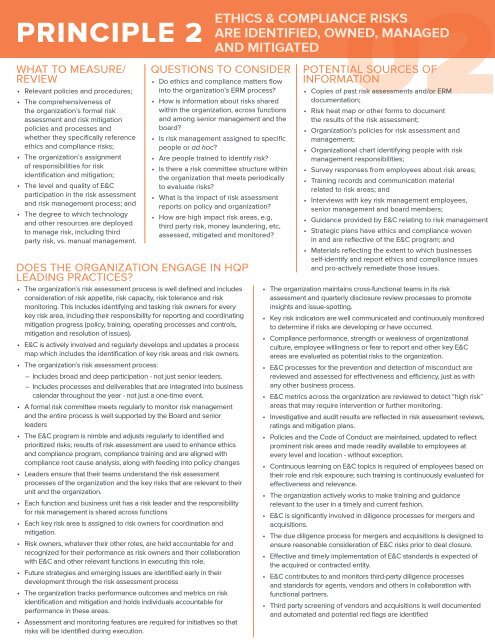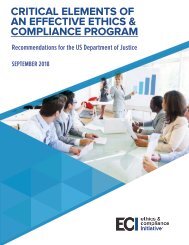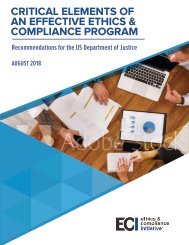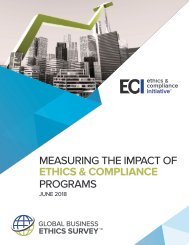ECI Maturity Model - DRAFT
You also want an ePaper? Increase the reach of your titles
YUMPU automatically turns print PDFs into web optimized ePapers that Google loves.
PRINCIPLE 2<br />
WHAT TO MEASURE/<br />
REVIEW<br />
• Relevant policies and procedures;<br />
• The comprehensiveness of<br />
the organization’s formal risk<br />
assessment and risk mitigation<br />
policies and processes and<br />
whether they specifically reference<br />
ethics and compliance risks;<br />
• The organization’s assignment<br />
of responsibilities for risk<br />
identification and mitigation;<br />
• The level and quality of E&C<br />
participation in the risk assessment<br />
and risk management process; and<br />
• The degree to which technology<br />
and other resources are deployed<br />
to manage risk, including third<br />
party risk, vs. manual management.<br />
QUESTIONS TO CONSIDER<br />
• Do ethics and compliance matters flow<br />
into the organization’s ERM process?<br />
• How is information about risks shared<br />
within the organization, across functions<br />
and among senior management and the<br />
board?<br />
• Is risk management assigned to specific<br />
people or ad hoc?<br />
• Are people trained to identify risk?<br />
• Is there a risk committee structure within<br />
the organization that meets periodically<br />
to evaluate risks?<br />
• What is the impact of risk assessment<br />
reports on policy and organization?<br />
• How are high impact risk areas, e.g,<br />
third party risk, money laundering, etc,<br />
assessed, mitigated and monitored?<br />
DOES THE ORGANIZATION ENGAGE IN HQP<br />
LEADING PRACTICES?<br />
• The organization’s risk assessment process is well defined and includes<br />
consideration of risk appetite, risk capacity, risk tolerance and risk<br />
monitoring. This includes identifying and tasking risk owners for every<br />
key risk area, including their responsibility for reporting and coordinating<br />
mitigation progress (policy, training, operating processes and controls,<br />
mitigation and resolution of issues).<br />
• E&C is actively involved and regularly develops and updates a process<br />
map which includes the identification of key risk areas and risk owners.<br />
• The organization’s risk assessment process:<br />
– Includes broad and deep participation - not just senior leaders.<br />
– Includes processes and deliverables that are integrated into business<br />
calendar throughout the year - not just a one-time event.<br />
• A formal risk committee meets regularly to monitor risk management<br />
and the entire process is well supported by the Board and senior<br />
leaders<br />
• The E&C program is nimble and adjusts regularly to identified and<br />
prioritized risks; results of risk assessment are used to enhance ethics<br />
and compliance program, compliance training and are aligned with<br />
compliance root cause analysis, along with feeding into policy changes<br />
• Leaders ensure that their teams understand the risk assessment<br />
processes of the organization and the key risks that are relevant to their<br />
unit and the organization.<br />
• Each function and business unit has a risk leader and the responsibility<br />
for risk management is shared across functions<br />
• Each key risk area is assigned to risk owners for coordination and<br />
mitigation.<br />
• Risk owners, whatever their other roles, are held accountable for and<br />
recognized for their performance as risk owners and their collaboration<br />
with E&C and other relevant functions in executing this role.<br />
• Future strategies and emerging issues are identified early in their<br />
development through the risk assessment process<br />
• The organization tracks performance outcomes and metrics on risk<br />
identification and mitigation and holds individuals accountable for<br />
performance in these areas.<br />
• Assessment and monitoring features are required for initiatives so that<br />
risks will be identified during execution.<br />
02<br />
documentation;<br />
ETHICS & COMPLIANCE RISKS<br />
ARE IDENTIFIED, OWNED, MANAGED<br />
AND MITIGATED<br />
POTENTIAL SOURCES OF<br />
INFORMATION<br />
• Copies of past risk assessments and/or ERM<br />
• Risk heat map or other forms to document<br />
the results of the risk assessment;<br />
• Organization’s policies for risk assessment and<br />
management;<br />
• Organizational chart identifying people with risk<br />
management responsibilities;<br />
• Survey responses from employees about risk areas;<br />
• Training records and communication material<br />
related to risk areas; and<br />
• Interviews with key risk management employees,<br />
senior management and board members;<br />
• Guidance provided by E&C relating to risk management<br />
• Strategic plans have ethics and compliance woven<br />
in and are reflective of the E&C program; and<br />
• Materials reflecting the extent to which businesses<br />
self-identify and report ethics and compliance issues<br />
and pro-actively remediate those issues.<br />
• The organization maintains cross-functional teams in its risk<br />
assessment and quarterly disclosure review processes to promote<br />
insights and issue-spotting.<br />
• Key risk indicators are well communicated and continuously monitored<br />
to determine if risks are developing or have occurred.<br />
• Compliance performance, strength or weakness of organizational<br />
culture, employee willingness or fear to report and other key E&C<br />
areas are evaluated as potential risks to the organization.<br />
• E&C processes for the prevention and detection of misconduct are<br />
reviewed and assessed for effectiveness and efficiency, just as with<br />
any other business process.<br />
• E&C metrics across the organization are reviewed to detect “high risk”<br />
areas that may require intervention or further monitoring.<br />
• Investigative and audit results are reflected in risk assessment reviews,<br />
ratings and mitigation plans.<br />
• Policies and the Code of Conduct are maintained, updated to reflect<br />
prominent risk areas and made readily available to employees at<br />
every level and location - without exception.<br />
• Continuous learning on E&C topics is required of employees based on<br />
their role and risk exposure; such training is continuously evaluated for<br />
effectiveness and relevance.<br />
• The organization actively works to make training and guidance<br />
relevant to the user in a timely and current fashion.<br />
• E&C is significantly involved in diligence processes for mergers and<br />
acquisitions.<br />
• The due diligence process for mergers and acquisitions is designed to<br />
ensure reasonable consideration of E&C risks prior to deal closure.<br />
• Effective and timely implementation of E&C standards is expected of<br />
the acquired or contracted entity.<br />
• E&C contributes to and monitors third-party diligence processes<br />
and standards for agents, vendors and others in collaboration with<br />
functional partners.<br />
• Third party screening of vendors and acquisitions is well documented<br />
and automated and potential red flags are identified








